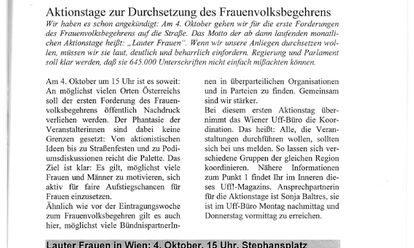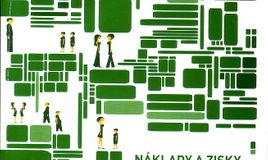Der Text des österreichischen Frauenvolksbegehrens

Article | Austria
English title: Text of the Austrian Women’s Referendum
Corporate author(s): Unabhängiges Frauenforum
Source: Uff! : Informationsblatt über das Frauenvolksbegehren und aktuelle Frauenpolitik; number: 3 (1997), (1)
Keyword(s): equal | opportunities policy | social security | single mothers | labour | labour law | pensions | maternity leave | minimum wage
Language(s): German
URL: http://www.parlament.gv.at/PG/DE/XX/I/I_00716/fname_139596.pdf
http://www.stichwort.or.at
Manifest: view document
Copyright:
![]() © Copyright Creative Commons License
© Copyright Creative Commons License
This work is licensed under a Creative Commons Attribution-NonCommercial-NoDerivs 3.0 Unported License.
Summary:
The 11 demands deal with the economic and social security of women: allocating subsidies and contracts to companies offering equal opportunities; equal pay for equal work and a minimum wage; equal rights for part time and marginal employment; no deduction of partner’s income for welfare; fostering equality through educational measures and annual gender-specific statistics on profession and education; provision of all-day qualified daycare facilities for children and social security for daycare providers; 2 years of maternity allowance for all single mothers; legally guaranteed claim to part time work for parents and the right to return to full time work; extension of job retention period after maternity leave; right to basic pension above the poverty line, obligation of life partners to contribute to pensions for partners who are not gainfully employed and credit for raising children and caregiving; no increase in the retirement age of women until actual equality has been reached.
FRAGEN Survey
Text of the Austrian Women’s Referendum (Austria):
Summarising questions regarding the identification of texts within the context of the FRAGEN project.
1. Is the document related to any particular event?
yes
2. If yes, what event?
Austrian Women’s Referendum, April 7-14, 1997
3. What does the document concern (According to: Beijing’s 12 critical areas of concern)?
Use the specifications major or minor to indicate the importance or the specification n/a if not applicable.
– poverty: major
– education: major
– health: N/A
– violence: N/A
– armed conflict: N/A
– economy: major
– power and decision making: major
– institutional mechanisms for the advancement of women: minor
– women’s rights (including sexuality): N/A
– media and culture: N/A
– environment: N/A
– girl child: N/A
– knowledge and science: N/A
4. Was the document written as a manifest?
yes
5. If no, did the document get the status of manifest afterwards?
null
Problematisation of gender in the text
6. Which of the following best describes the use of gender in the document?
Use the specifications major or minor to indicate the importance or the specification n/a if not applicable.
– Is there just simple reference to the categories of women and men, without further reflection?: major
– Is there explicit reference to men and women as biologically different categories?: N/A
– Is there explicit reference to gender (as social categories)?: N/A
– Is there implicit reference to categories that are known to be gendered, for example, that they are disproportionately constituted by men or women (e.g. main carer, main earner)?: N/A
– Is there reference to gender as intersected by other inequalities?: major
7. Does the document deal with causes for the established problems/gender inequalities?
yes
8. Who or what is seen to cause the problem(s)?
Use the specifications major or minor to indicate the importance or the specification n/a if not applicable.
– economy/the market: major
– patriarchy: N/A
– biology: N/A
– sexuality: N/A
– symbolic order: N/A
– social relations: major
– religion/the church: N/A
– traditions/culture: N/A
– polity: major
– men: N/A
– women: N/A
Feminism framing
9. Which type of feminism occurs in the document?
(According to: Judith Lorber (2010) Gender inequality: feminist theories and politics).
Use the specifications major or minor to indicate the importance or the specification n/a if not applicable.
– liberal feminism: major
– Marxist feminism: N/A
– socialist feminism: N/A
– postcolonial feminism: N/A
– radical feminism: N/A
– lesbian feminism: N/A
– psychoanalytic feminism: N/A
– standpoint feminism: N/A
– multiracial/multiethnic feminism: N/A
– feminist studies of men: N/A
– social construction feminism: N/A
– postmodern feminism and queer theory: N/A
– third-wave feminism: N/A
Intersectionality
10. If there is reference to any other inequality than gender please specify for each case
if the intersection of gender with the other inequalities is mentioned, if there is a major or minor link with gender,
or not applicable (n/a) if there is no reference to intersection of gender with other inequalities.
– ethnic or racial inequality, e.g. reference to ethnic minority or ‘racial’ groups (including Roma), or reference to racism/white privilege: null
– religion or belief, e.g. reference to minority or non-dominant religious groups, to the moral preferences of the majority religion or to any form of religion bashing: N/A
– class inequality, e.g. reference to economically disadvantaged groups, social exclusion minor link with gender sexual orientation, e.g. reference to gay, lesbian, bisexual or other orientations, or reference to homophobia/heteronormativity: N/A
– age, e.g. reference to older people or youth mentioned disabled people: N/A
– marital/family status: N/A
– regional dimension (e.g central cities/periphere villages): N/A
The broad framing of the text
11. Does the document refer to any of the following broader normative goals or ideals?
Use the specifications major or minor to indicate the importance or the specification n/a if not applicable.
– equality (whether gender equality or other equality): major
– human rights (including dignity): N/A
– economic development (including economic growth): minor
– capabilities and well-being (including health): N/A
– law and order: N/A
– social justice: major
– autonomy: N/A
– solidarity: N/A
– liberty/liberation: N/A
– empowerment: N/A
– democracy: N/A
– emancipation: N/A
– difference: N/A
Call for action
12. Does the document call for (a) particular action(s)?
yes
13. Does this call ask for any of the following?
Use the specifications major or minor to indicate the importance or the specification n/a if not applicable.
– awareness raising: N/A
– behavioral change: N/A
– political pressure: major
– mobilisation of civil society: N/A
– changes in laws or regulations: major
– redistribution of resources: major
– recognition of people, values or identities: N/A
– representation in decision making: major
– transformation: major
– (violent) revolution: N/A
14. Does the call for action involve that any of the actors below need to do something?
Use the specifications major or minor to indicate the importance or the specification n/a if not applicable.
You can specify the actors at question 15.
– national government actors: major
– any governmental gender or equalities machinery: major
– national market actors: major
– actors at the EU level (e.g. Council of Europe): N/A
– international actors (e.g. CEDAW): N/A
– women’s NGO or women’s movements (including feminists): N/A
– gender experts (academia/professionals): minor
– other civil society actors (including trade unions): N/A
– men: major
– women: major
– intersectional: N/A
15. Please specify the actors selected above (See question 14).
– national government actors: Legislation, social services
– any governmental gender or equalities machinery: Legislation, social services
– national market actors private sector actors at the EU level (e.g. Council of Europe): null
– international actors (e.g. CEDAW): null
– women’s NGO or women’s movements: null
– gender experts (academia/professionals): experts for the accompanying statistical research
– other civil society actors (including trade unions): null
– men: the electorate
– women: the electorate
– intersectional: null
Civil society/state interface
16. Does the document see cooperation with the state as positive, negative or neutral?
positive
17. Does the document call for the state to consult with feminist organisations or women’s movements
(Can include the authors of the document)?
no
18. Does the document call for cooperation with others or for alliance with others?
yes
19. If yes, with whom?
null
20. Comments
The Women’s Referendum was carried out on the initiative of the Unabhängiges Frauenforum – UFF from April 7-14, 1997. The UFF was supported by women from institutional politics, media, and the autonomous women’s movement. 644,977 signatures were gathered, making it the second most successful referendum in Austria.
Date Created: 2010-04-09 13:12:16.0
Last Updated: 2010-08-06 15:01:53.0




